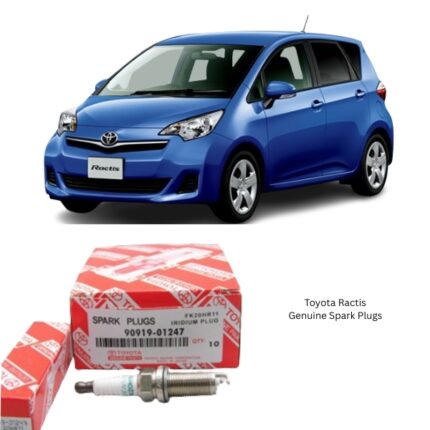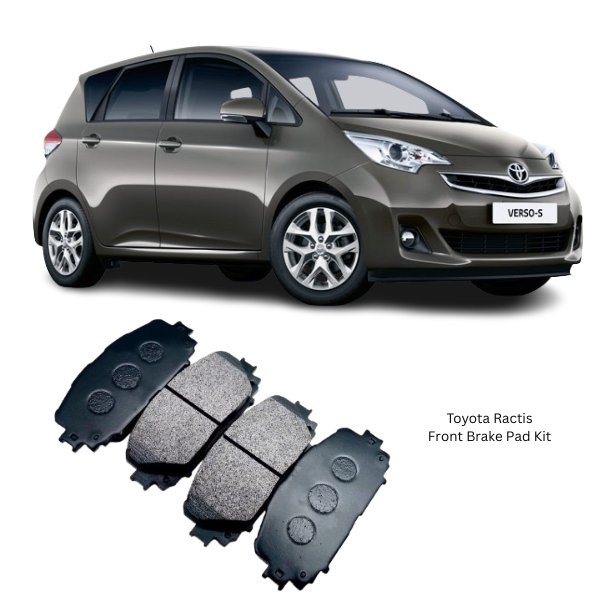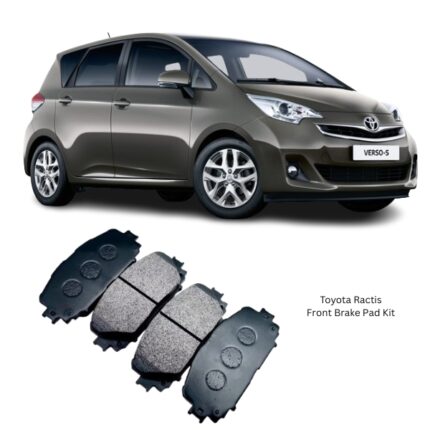Get Toyota Ractis Front Brake Pad Kit D2253 in Kenya
The Front Brake Pad Kit is an essential component of a vehicle’s disc braking system, engineered to deliver reliable stopping performance, reduced noise, and enhanced driving safety. Positioned within the brake calipers of the front wheels, brake pads work by generating friction against the brake discs (rotors) when pressure is applied to the brake pedal. The result is a controlled reduction in wheel speed, converting kinetic energy into thermal energy.
Since the front brakes perform a majority of the braking work—due to weight transfer during deceleration—the pads installed here are subject to greater loads and heat compared to their rear counterparts. Therefore, selecting a high-quality front brake pad kit is critical for maintaining optimal braking efficiency and safety.
Function of the Front Brake Pad Kit
At its core, the front brake pad kit ensures that the vehicle can decelerate and stop in a predictable, responsive, and smooth manner. When the brake pedal is pressed, hydraulic force is transmitted through the brake lines to the front calipers. These calipers squeeze the brake pads against the rotors. The friction generated between the pads and the rotors produces the stopping force required to slow or halt the vehicle.
As the leading elements of this operation, the brake pads must balance frictional strength with thermal resistance, wear characteristics, and durability. The front brake pad kit is therefore not just a set of pads but a comprehensive assembly designed for performance, ease of installation, and longevity.
Contents of a Typical Front Brake Pad Kit
A complete front brake pad kit usually includes the following components:
-
Two front brake pad sets (one per wheel).
-
Anti-noise shims or backing plates, attached to the pad backs to suppress vibration and noise.
-
Wear indicators (mechanical or electronic), which alert the driver when pad thickness is critically low.
-
Hardware clips, such as abutment clips or retaining springs, to secure the pads within the caliper brackets.
-
Brake lubricant, often included in small sachets to assist with lubrication of contact points and prevent squeal.
Each component plays a vital role in the smooth function of the braking system.
Materials Used in Front Brake Pads
The materials used to manufacture brake pads determine their effectiveness, temperature resistance, wear rate, and noise level. The main material types include:
-
Ceramic
Composed of ceramic fibers, bonding agents, and nonferrous filler materials, ceramic pads are valued for their quiet operation, minimal dust output, and consistent performance. They perform well under typical driving conditions and resist wear, making them a popular choice for daily use. -
Semi-Metallic
These pads consist of metal fibers (steel, iron, copper) mixed with resin and other fillers. They offer high thermal conductivity and strong braking performance, especially under heavier loads. They are more aggressive on rotors and can be noisier than ceramic options. -
Organic (Non-Asbestos Organic – NAO)
Made from rubber, glass, resin, Kevlar, and other organic fibers, these pads are soft and quiet but tend to wear faster. They are better suited to lighter-duty use and offer a smooth braking feel.
Each material type presents a trade-off between longevity, cost, noise, dust levels, and braking power.
Key Performance Attributes
A front brake pad kit must meet rigorous performance standards to ensure the safety of occupants and optimal driving dynamics. Key performance characteristics include:
-
Friction Coefficient Stability: Pads must provide consistent braking force across various temperature ranges and conditions.
-
Thermal Resistance: Effective dissipation of heat prevents brake fade and component damage under sustained or repeated braking.
-
Low Noise Output: Design elements such as shims, slots, and chamfers reduce vibrations and eliminate unwanted squealing or grinding noises.
-
Low Dust Generation: Minimizing dust output helps keep wheels cleaner and reduces environmental impact.
-
Pad and Rotor Life: Long-lasting materials reduce maintenance intervals and costs.
Design Features
Modern front brake pad kits are engineered with advanced design features to enhance durability and user experience:
-
Chamfered Edges: Help reduce initial contact noise and prevent pad edge lifting.
-
Slots: Aid in heat dissipation, water dispersion, and gas evacuation from the pad-rotor interface.
-
Multi-Layer Shims: Reduce vibrations and act as insulation barriers for noise suppression.
-
Scorched or Heat-Treated Surfaces: Ensure a quicker bedding-in process and consistent braking behavior from the start.
These design elements combine to deliver quieter operation, improved performance, and longer service life.
Installation Considerations
Proper installation is critical for maximizing the lifespan and effectiveness of the front brake pad kit. During installation:
-
The caliper must be safely removed and suspended without straining the brake hose.
-
The rotor should be inspected and either resurfaced or replaced if worn, scored, or warped.
-
The caliper slides, pins, and hardware must be cleaned and lubricated with suitable high-temperature grease.
-
Brake pad surfaces should never be contaminated with grease, oil, or debris.
-
Torque specifications for caliper bolts and hardware must be followed precisely.
-
After installation, a proper bedding-in procedure must be performed to allow the pads and rotors to mate effectively.
Improper installation can result in uneven pad wear, brake noise, or reduced braking performance.
Maintenance and Lifespan
The front brake pad kit is a wear component that should be inspected regularly and replaced at appropriate intervals. On average, front brake pads last between 30,000 to 70,000 kilometers, though actual lifespan varies depending on driving style, terrain, load, and material composition.
Indicators that replacement is needed include:
-
Squealing or grinding noise during braking.
-
Reduced braking performance or longer stopping distances.
-
A soft or spongy brake pedal.
-
Visible wear or thinning of the pad friction material.
-
Brake warning light activation (for pads with electronic wear sensors).
Routine inspection of the braking system helps prevent unsafe conditions and protects related components like rotors and calipers from premature damage.
Environmental and Safety Considerations
Newer brake pad formulations are designed with low-copper or copper-free technologies in compliance with environmental regulations aimed at reducing heavy metal runoff. Brake pad dust contributes to urban air and water pollution, making eco-conscious material choices increasingly important.
From a safety standpoint, using a well-manufactured front brake pad kit ensures:
-
Consistent and reliable braking in all weather conditions.
-
Quick response in emergency stop scenarios.
-
Better control on inclines, declines, or wet surfaces.
Neglecting pad condition can compromise braking efficiency and overall vehicle control.
Follow us on Facebook for more parts.





Reviews
Clear filtersThere are no reviews yet.